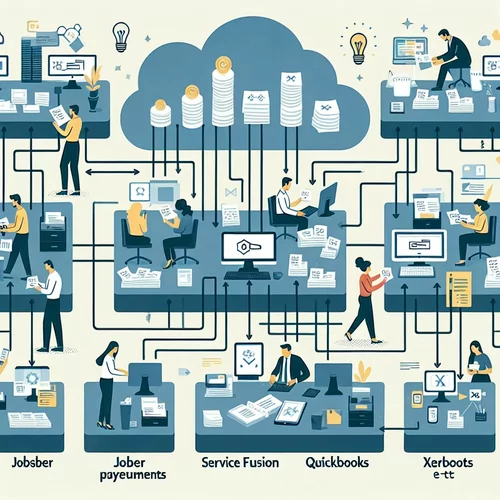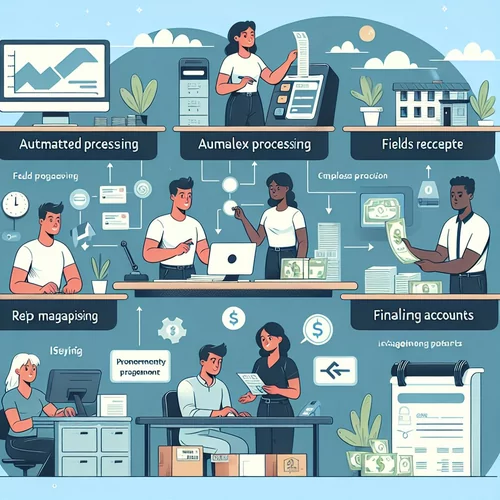Ever wondered how nonprofits navigate the financial maze to emerge successful? It’s not just about number-crunching; it’s an artful blend of fiscal savvy and mission-driven stewardship. In this guide, we’re peeling back the curtain on nonprofit accounting, serving up the strategies that spell financial prosperity.
Whether you’re a board member, a nonprofit pro, or just plain curious, we’ve got the lowdown on everything from compliance to cash flow. So buckle up, and let’s embark on this journey to financial enlightenment in the nonprofit realm.
Understanding Nonprofit Accounting: An Overview
Nonprofit accounting is its own beast, juggling tax-exempt nuances with a mandate for crystal-clear accountability. It’s all about painting a true picture of financial health, crucial for informed decision-making and ironclad transparency. Nonprofits tap into a kaleidoscope of funding sources, each with its own reporting rhythm, making their financial statements a unique tableau of mission over margin.
But it’s not just about keeping the books. Nonprofit accountants dance to a tune set by the likes of the FASB and IRS, ensuring every step is in line with the strictest of guidelines. Understanding these nonprofit-specific beats is key to keeping your organization in the financial groove.
The Importance of Financial Reporting for Nonprofit Organizations
Financial reporting is the nonprofit’s megaphone, broadcasting the fiscal state of affairs to the world. It’s a symphony of balance sheets, income statements, and cash flow reports, all harmonizing to showcase the organization’s financial footing. These reports are the bread and butter for stakeholders, laying bare the nonprofit’s prowess in managing its monetary resources.



But there’s more to the story. Nonprofits must also master the art of the Form 990 and grant reports, ensuring they stay in the good graces of the IRS and funders alike. It’s about more than just numbers; it’s about nurturing trust through unwavering accuracy and accountability.
Navigating Nonprofit Budgeting: Tips and Best Practices
Budgeting in the nonprofit world is a delicate balancing act, a strategic choreography of resources that supports the mission while keeping the books in the black. Here’s how to hit the high notes:
- Align budget with strategic goals: Make sure your budget mirrors your mission, channeling funds where they’ll fuel your long-term vision.
- Involve key stakeholders: Bring everyone to the table. Their collective wisdom will shape a budget that everyone’s invested in.
- Consider multiple scenarios: The nonprofit landscape is ever-shifting. Flexibility in your budget can help you pivot with poise.
- Monitor and adjust: Keep a watchful eye on your finances. When reality deviates from the plan, be ready to recalibrate.
With these best practices, your nonprofit’s budget can become a beacon of fiscal responsibility, illuminating the path to your mission’s success.
Ensuring Compliance with Nonprofit Accounting Regulations
Staying on the right side of regulations is non-negotiable for nonprofits. It’s about dotting the i’s and crossing the t’s across a spectrum of IRS and FASB directives. Here’s the compliance checklist:
- Maintain accurate records: Keep a meticulous log of every penny that passes through your doors.
- Fulfill reporting requirements: Stay punctual and precise with your Form 990s and state reports.
- Follow accounting standards: Let the nonprofit accounting principles be your guide when crafting financial statements.
- Educate board members and staff: Spread the knowledge. When your team is clued in on regulations, compliance is a breeze.
Consider enlisting a nonprofit accounting virtuoso to keep your organization in harmony with the law.
The Role of Internal Controls in Nonprofit Financial Management
Internal controls are the guardians of your nonprofit’s treasure. They’re the checks and balances that keep your assets safe and your financial records spot-on. Here’s what they do:
- Maintain accurate financial records: Good controls mean fewer financial fumbles.
- Prevent fraud: With solid controls, you’re building a fortress against fraudsters.
- Safeguard assets: Protect your nonprofit’s valuables from being pilfered or misused.
- Demonstrate accountability: Show the world that your nonprofit is a paragon of transparency.
Regular risk assessments and well-documented policies are your best defense, turning your nonprofit into a stronghold of financial integrity.
Strategies for Effective Cash Flow Management in Nonprofit Organizations
Mastering the ebb and flow of cash is vital for a nonprofit’s vitality. It’s about keeping your coffers ready for whatever lies ahead. Here’s how to stay afloat:
- Create a cash flow forecast: Chart your financial future to sidestep any cash crunches.
- Manage accounts receivable: Chase down those dues with gusto to keep the cash coming.
- Negotiate favorable payment terms: Sweet-talk suppliers into payment schedules that sync with your cash rhythm.
- Control expenses: Keep a hawk’s eye on spending, trimming the fat without nicking your mission.
Stay vigilant, and adjust your sails as the financial winds shift. That’s the secret to cash flow mastery.



Maximizing Revenue Generation: Fundraising and Grant Management
When it comes to revenue, nonprofits need to play a smart game of chess, strategizing every move in fundraising and grant management. Here’s the game plan:
- Create a diversified fundraising strategy: Don’t put all your eggs in one basket. Mix it up to keep the funds flowing.
- Cultivate relationships with donors: Woo your benefactors. Their ongoing support is worth its weight in gold.
- Invest in fundraising infrastructure: Build a solid foundation for your fundraising efforts, and watch them soar.
And when it comes to grants, it’s all about precision and prowess:
- Research grant opportunities: Keep your ear to the ground for grants that resonate with your mission.
- Develop compelling proposals: Craft proposals that hit the mark, showcasing your nonprofit’s vision and vigor.
- Establish strong grant management systems: Keep your grant game tight with systems that track and report with finesse.
With these strategies, your nonprofit can turn fundraising and grants into a revenue revolution.
Evaluating Performance and Impact through Nonprofit Financial Analysis
Financial analysis is the nonprofit’s telescope, zooming in on fiscal performance and program impact. It’s about metrics that matter, ratios that reveal, and insights that inspire. Here’s what to measure:
- Liquidity ratios: Can you cover the bills? Keep an eye on your current and quick ratios.
- Solvency ratios: Are you built to last? Debt-to-equity and interest coverage ratios will tell.
- Program efficiency ratios: How well are you delivering on your promise? Program expense and fundraising efficiency ratios hold the answers.
Financial analysis is your compass, guiding your nonprofit through the seas of fiscal responsibility.
Leveraging Technology for Streamlined Nonprofit Accounting
Technology is the nonprofit’s ace in the hole, a game-changer for accounting efficiency. With the right software, you can automate the mundane and focus on what really matters—your mission. Look for tools that track donations, manage grants, and whip up reports with ease. And don’t forget the cloud—it’s your ticket to anytime, anywhere access to your financial lifeblood.
When choosing your tech, weigh factors like user-friendliness, growth potential, and the ability to play nice with your other systems. It’s about finding the perfect fit for your nonprofit’s unique needs.
And speaking of technology that transforms, let’s talk about Clyr. Clyr is not just another expense management platform; it’s a revolution for companies with teams in the field. Imagine condensing a week’s worth of accounting into a few clicks, all while keeping your existing cards and accounts. That’s Clyr.
With Clyr, you’re not just tracking expenses; you’re unlocking a treasure trove of data that’s been hiding in plain sight. It’s about real-time notifications, seamless receipt capture, and a dramatic uptick in expense categorization. And let’s not forget the integrations—Clyr plays well with the big boys of work management and accounting platforms.
For nonprofits, this means job costing and expense oversight that’s not just efficient—it’s revolutionary. Clyr is the ally you need to navigate the nonprofit accounting landscape with confidence and clarity.



The Future of Nonprofit Financial Management: Trends to Watch
As the nonprofit sector evolves, so does the financial management landscape. Staying ahead of the curve is essential for survival and success. Here are the trends making waves:
- AI and Machine Learning: These technologies are refining expense management automation, predicting cash flow trends, and personalizing donor experiences.
- Increased Transparency: Donors demand it, and technology delivers. Real-time reporting and open books are becoming the norm.
- Mobile Accessibility: Financial management on the go is a must, with apps for everything from receipt management to donor communications.
These trends are not just passing clouds; they’re the forecast for a brighter, more efficient future in nonprofit financial management.
Case Studies: Nonprofits Thriving with Advanced Accounting Solutions
Let’s take a peek at nonprofits that have leaped into the future with advanced accounting solutions:
- The Green Canopy Initiative: By adopting AP Automation, this environmental nonprofit cut down on paper waste and processing time, a true win-win for their mission.
- Art for All: This arts education nonprofit used expense reporting in QuickBooks integration to streamline their finances, freeing up more funds for community programs.
- Global Health Corps: With accounts payables automation, this health-focused organization managed to allocate more resources to frontline services, enhancing their global impact.
These stories are not just inspiring; they’re a roadmap for other nonprofits seeking financial transformation.
Choosing the Right Financial Software for Your Nonprofit Organization
It’s a digital jungle out there, and choosing the right financial software for your nonprofit can feel like finding a needle in a haystack. Here’s your compass:
- Assess Your Needs: Do you need expense report automation, donor tracking, or grant management? Pinpoint your pain points.
- Scalability: Pick a platform that grows with you. Today’s sapling is tomorrow’s oak.
- Support and Training: Ensure the software comes with a lifeline. You’ll want help when the waters get choppy.
Remember, the right tool not only fits your current situation but also paves the way for future growth.
Nonprofit Accounting FAQs: Your Questions Answered
Got burning questions about nonprofit accounting? You’re not alone. Here’s the lowdown on the most common head-scratchers:
How is nonprofit accounting different from for-profit accounting? Nonprofits focus on accountability over profitability, with unique reporting requirements like the Form 990. Can nonprofits use any accounting software? They can, but software tailored for nonprofits, like Clyr, can better handle specific needs like fund accounting and donor reporting. What’s the deal with fund accounting? It’s a method that nonprofits use to track restricted and unrestricted funds, ensuring they’re used according to donor intent.
These FAQs are just the tip of the iceberg, but they’re a solid start to understanding the nonprofit accounting world.



Building a Culture of Financial Accountability in Nonprofits
Financial accountability is not just a policy; it’s a culture. Here’s how to weave it into the fabric of your nonprofit:
- Lead by Example: When leaders champion transparency, it trickles down.
- Regular Training: Keep your team sharp on the latest in nonprofit finance.
- Open Communication: Foster an environment where questions about money are not just tolerated but encouraged.
When accountability is part of your culture, trust and integrity become your nonprofit’s calling cards.
Next Steps: Implementing Best Practices in Your Nonprofit’s Accounting
Ready to take the plunge? Here’s how to implement best practices in your nonprofit’s accounting:
- Embrace Technology: Tools like Clyr can revolutionize your financial processes, from expense report automation to expense reporting in QuickBooks.
- Train Your Team: Invest in training to ensure everyone’s up to speed on the latest tools and techniques.
- Monitor and Adjust: Keep an eye on your financial health and be ready to pivot when necessary.
With these steps, you’re not just keeping up; you’re setting the pace in nonprofit financial management.